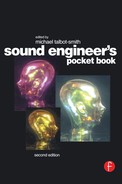Weighting Curves
The French CCIR 468–4 is universally adopted for measurements of noise in audio systems. It is shown in Figure 113. The ‘unweighted’ response curve is needed to avoid the effects of inaudible components which may be present. The A-weighting curve using similar scales is shown in Figure 114 for comparison. The tables give precise values and tolerances.

Figure 113 CCIR 468–4 noise weighting curves

Figure 114 A weighting curve (IEC179)
The use of Special dB Suffices in Audio Engineering
Note: A suffix applied to the expression dB is contained in brackets only where it denotes a reference quantity, e.g. dB (mW) expresses a power measurement compared to a reference quantity of 1 mW.
dBu – informal abbreviation of dB (0.775 V)
dBm – informal abbreviation for dB (mW)
dBA – weighted sound pressure level in accordance with BS EN 60651: 1994 (SLOW dynamic)
dBq – audio system noise level (unweighted) using quasi-peak equipment conforming to CCIR 468–4
dBqp – audio system noise level (weighted) using quasi-peak equipment conforming to CCIR 468–4
Audio System Noise Measurements
Quasi-peak noise measurement equipment conforming to CCIR-4 (see list of standards) is now generally employed for measurements of noise in audio systems. Weighted measurements are made through the curve shown in Figure 113 while the band-pass response for unweighted measurements is also incorporated to eliminate the effect of inaudible components. For expression of readings, use of the quasi-peak dynamic response means that neither dBu nor dBm is appropriate. The standard accordingly specifies the use of dBq and dBqp for unweighted and weighted measurements respectively. On professional equipment noise measurements are made at points where the audio signal peaks to the equivalent of +8 dBu, while the normal line-up tone level of 0 dBu at 1 kHz gives a reading of 0 dBq/0 dBqp on the noise meter.
Weighting Curves
Programme Level Measurements
At the output of professional mixing equipment there is normally a standard programme level meter; this may be either of two patterns:
(a) VU (volume unit) meter. Although this is basically just a moving-coil meter fitted with a bridge rectifier, the ballistics of the meter are very closely specified and only instruments conforming to the IEC/ASA standard should be used (see list of standards). Correct use of the VU meter requires special training and experience.
(b) PPM (peak programme meter). The basic instrument consists of a moving-coil meter having very closely specified ballistics combined with electronic processing to give rapid pointer rise-time and slow fall-back. There are two instruments, standarized by the IEC (see list of standards) and having significantly different characteristics. The ‘type 1’ (DIN) version has a longer scale and an Integration Time of 5 ms, whereas the ‘type 2a’ (UK) version has a scale length of 24 dB and an Integration Time of 10 ms. The ‘type 2a’ specification additionally calls for a ‘preferred display meter’, covering electrical, dynamic and scale marking features; it is generally used on broadcasting equipment throughout the UK. (The type 2b PPM only differs in respect of the EBU scale.)
Standards Relating to Audio Measurement
Programme Level Measurement
IEC 60268–10 (2nd edition): 1991/BS 6840: Part 10: 1991 Sound System Equipment Part 10: Methods for specifying and measuring the characteristics of peak programme level meters (Definitive information on PPMs – Type 1 (DIN) and Type 2a/b (UK/EBU).)
IEC 60268–17: 1990/BS 6840: Part 17: 1991
Sound System Equipment, Part 17: Methods for specifying and measuring the characteristics of standard volume indicators (Replaces ANSI/ASA C16.5:1954 – original VU meter specification.)
IEC 60268–18 (1st edition): 1995/BS 6840: Part 18: 1996
Sound System Equipment, Part 18: Peak programme level meters: Guide for digital audio level meter
ITU/R Report BS 292 (was CCIR 292–2) Use of IEC type 1 PPM
ITU/R Report BS 820–1: 1994 (was CCIR 820–1) Comparison of readings using VU meter and PPM
Audio System Noise Measurement
ITU/R Recommendation BS 468–4: 1994, Measurement of Audiofrequency Noise Voltage Level in Sound Broadcasting (formerly CCIR REC 468–4: 1990) Note: with the exception of the original edition, (CCIR REC 468.1970 which retained RMS noise measurement) previous editions had slightly different tolerances but were essentially the same.
AES presentation, CCIR/ARM, A Practical Noise Measurement Method, Audio Engineering Society, 60th Convention, Los Angeles (1978).
